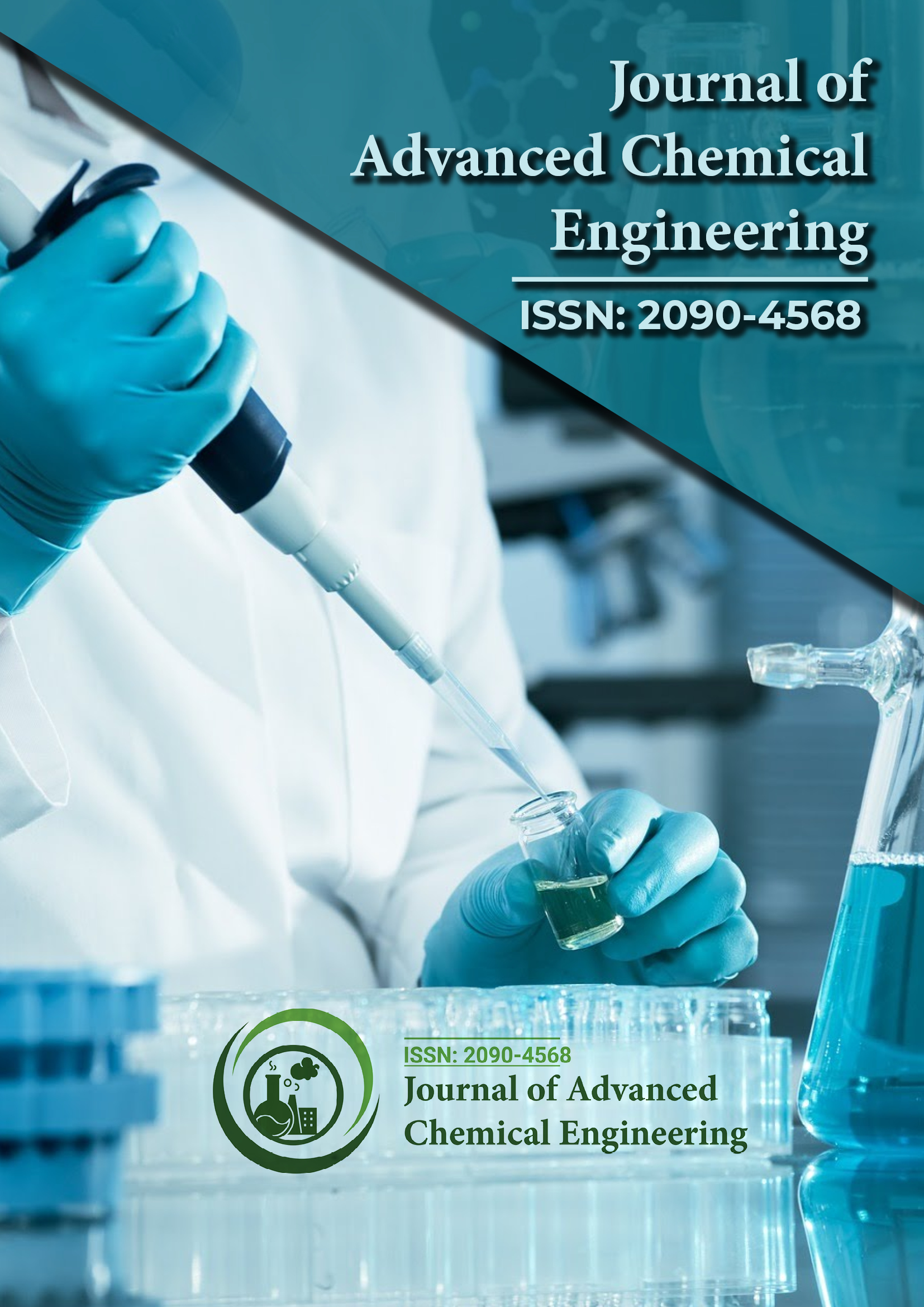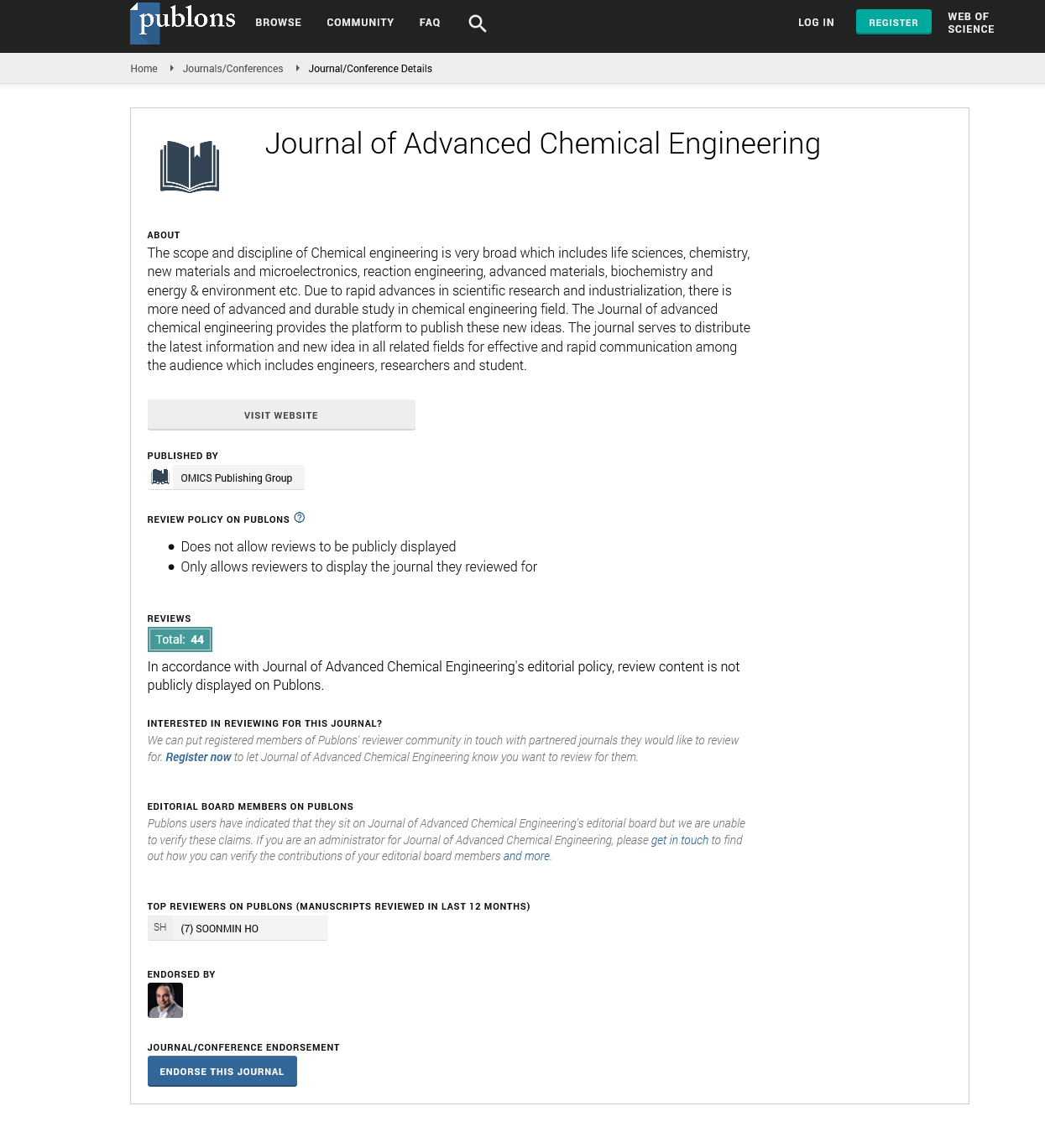Indexed In
- Open J Gate
- Genamics JournalSeek
- Smithers Rapra
- RefSeek
- Directory of Research Journal Indexing (DRJI)
- Hamdard University
- EBSCO A-Z
- OCLC- WorldCat
- Scholarsteer
- Publons
- Geneva Foundation for Medical Education and Research
- Google Scholar
Useful Links
Share This Page
Journal Flyer

Open Access Journals
- Agri and Aquaculture
- Biochemistry
- Bioinformatics & Systems Biology
- Business & Management
- Chemistry
- Clinical Sciences
- Engineering
- Food & Nutrition
- General Science
- Genetics & Molecular Biology
- Immunology & Microbiology
- Medical Sciences
- Neuroscience & Psychology
- Nursing & Health Care
- Pharmaceutical Sciences
Short Communication - (2024) Volume 14, Issue 4
Catalyst Support Modification Tailoring Pore Structure and Surface Chemistry
Anastasia Georgiou*Received: 28-Nov-2024, Manuscript No. ACE-24-28361; Editor assigned: 02-Dec-2024, Pre QC No. ACE-24-28361 (PQ); Reviewed: 16-Dec-2024, QC No. ACE-24-28361; Revised: 23-Dec-2024, Manuscript No. ACE-24-28361 (R); Published: 30-Dec-2024, DOI: 10.35248/2090-4568.24.14.353
Description
The design and engineering of microenvironments around supported catalysts have emerged as a critical approach to improving the efficiency of chemical synthesis. Supported catalysts, which are typically metal or metal oxide nanoparticles dispersed on solid supports, are the foundation of many industrial processes, including petroleum refining, fine chemical production and environmental remediation [1,2]. However, traditional catalyst systems often suffer from issues such as low selectivity, rapid deactivation and limited activity under certain reaction conditions. By engineering the microenvironments surrounding the catalyst, researchers aim to overcome these challenges and enhance catalytic performance, making reactions more efficient and sustainable [3].
The microenvironment around a catalyst refers to the localized space where the catalytic reaction occurs, including the interactions between the catalyst, reactants, solvents and other components [4]. By customizing these interactions, it is possible to control reaction pathways, improve stability and reduce undesirable side reactions. One of the primary strategies for engineering microenvironments is modifying the physical and chemical properties of the catalyst support [5]. For example, porous supports such as silica, alumina and zeolites can be engineered to create specific pore sizes and surface chemistries that favor particular reactions. The size, shape and distribution of the pores can influence the accessibility of reactants to the active sites, thereby impacting the reaction rate and selectivity [6].
Another approach is the functionalization of the support material with specific chemical groups that interact with the reactants or products. By introducing hydrophobic or hydrophilic regions, for example, researchers can control the solubility of reactants and enhance the dispersion of catalysts, thereby promoting efficient reactions [7]. Furthermore, doping the catalyst support with metal or non-metal species can create local electronic or steric effects that influence the electronic properties of the active sites. These changes can lead to improved catalytic activity, stability and selectivity by altering the nature of the interaction between the catalyst and the reactants.
The incorporation of nanostructured supports is another promising direction for the design of catalytic microenvironments. Nanomaterials, such as carbon nanotubes, graphene and Metal- Organic Frameworks (MOFs), offer high surface areas and tunable surface properties that can be customized to optimize catalytic performance [8]. For example, the high surface area of nanostructured materials provides more active sites, which can increase the catalytic efficiency of reactions. In addition, the unique electronic properties of nanomaterials can enable new catalytic mechanisms, allowing for more selective and energyefficient processes [9].
The integration of green chemistry principles into the design of catalyst microenvironments is also gaining importance [10]. With growing concerns about sustainability and environmental impact, the design of catalysts that can operate under mild reaction conditions, use renewable feedstocks and minimize waste is critical. By engineering microenvironments that minimize the use of hazardous solvents and reduce energy consumption, more sustainable catalytic processes can be developed.
In conclusion, the engineering of microenvironments around supported catalysts is a promising approach to improving the efficiency of chemical synthesis. By controlling the interactions between the catalyst, reactants and environment, it is possible to enhance catalytic performance in terms of activity, selectivity and stability. Advances in catalyst design, including the use of customized supports, nanomaterials and green chemistry principles, are creating the path for more efficient and sustainable chemical processes. As research in this area continues to evolve, it holds great potential for addressing the increasing demand for more efficient and environmentally friendly chemical synthesis techniques.
References
- Chen T, Xu Z. Design and engineering of microenvironments of supported catalysts toward more efficient chemical synthesis. Adv Colloid Interface Sci. 2024;337:103387.
[Crossref] [Google Scholar] [PubMed]
- Zheng Y, Wang P, Huang WH, Chen CL, Jia Y, Dai S, et al. Toward more efficient carbon-based electrocatalysts for hydrogen peroxide synthesis: roles of cobalt and carbon defects in two-electron ORR catalysis. Nano Lett. 2023;23(3):1100-8.
[Crossref] [Google Scholar] [PubMed]
- Najafpour MM. An approach for catalyst design in artificial photosynthetic systems: Focus on nanosized inorganic cores within proteins. Photosynth Res. 2013;117(1-3):197-205.
[Crossref] [Google Scholar] [PubMed]
- Delidovich IV, Simonov AN, Taran OP, Parmon VN. Catalytic formation of monosaccharides: From the formose reaction towards selective synthesis. ChemSusChem. 2014;7(7):1833-46.
[Crossref] [Google Scholar] [PubMed]
- Magin CM, Alge DL, Anseth KS. Bio-inspired 3D microenvironments: A new dimension in tissue engineering. Biomedical Materials. 2016;11(2):022001.
[Crossref] [Google Scholar] [PubMed]
- Wang C, Zhang Q, Yan B, You B, Zheng J, Feng L, Zhang C, Jiang S, Chen W, He S. Facet engineering of advanced electrocatalysts toward hydrogen/oxygen evolution reactions. Nanomicro Lett. 2023;15(1):52.
[Crossref] [Google Scholar] [PubMed]
- Xiao K, Shen Y, Liang S, Tan J, Wang X, Liang P, Huang X. Characteristic regions of the fluorescence Excitation-Emission Matrix (EEM) to identify hydrophobic/hydrophilic contents of organic matter in membrane bioreactors. Environ Sci Technol. 2018;52(19):11251-11258.
[Crossref] [Google Scholar] [PubMed]
- Pandey RR, Chusuei CC. Carbon nanotubes, graphene, and carbon dots as electrochemical biosensing composites. Molecules. 2021;26(21):6674.
[Crossref] [Google Scholar] [PubMed]
- Jin G, Kim SH, Han HJ. Synthesis and future electronic applications of topological nanomaterials. Int J Mol Sci. 2023;25(1):400.
[Crossref] [Google Scholar] [PubMed]
- Schwartz TJ, Johnson RL, Cardenas J, Okerlund A, Da Silva NA, Schmidt‐Rohr K, et al. Engineering catalyst microenvironments for metal‐catalyzed hydrogenation of biologically derived platform chemicals. Angew Chem Int Ed Engl. 2014;53(47):12718-22.
[Crossref] [Google Scholar] [PubMed]
Citation: Georgiou A (2024). Catalyst Support Modification Tailoring Pore Structure and Surface Chemistry. Adv Chem Eng. 14:353.
Copyright: © Georgiou A. This is an open access article distributed under the terms of the Creative Commons Attribution License, which permits unrestricted use, distribution, and reproduction in any medium, provided the original author and source are credited.

